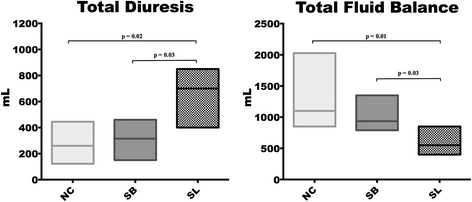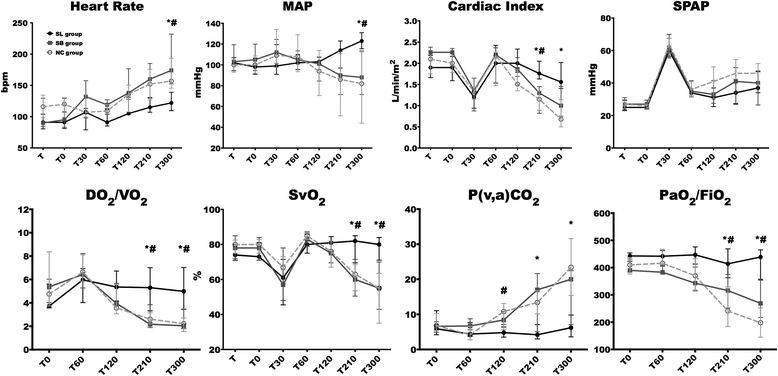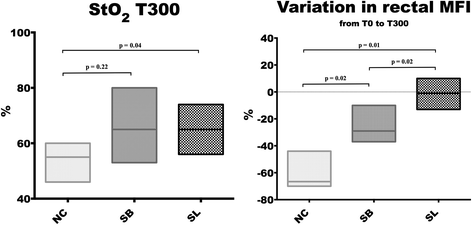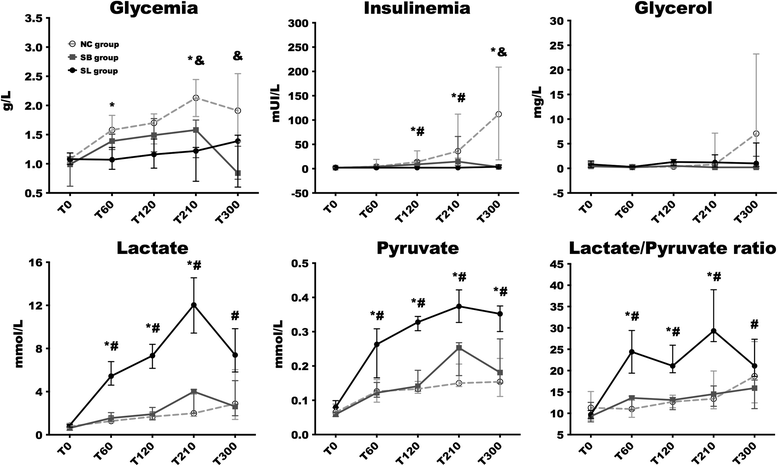Comparison of fluid balance and hemodynamic and metabolic effects of sodium lactate versus sodium bicarbonate versus 0.9% NaCl in porcine endotoxic shock: a randomized, open-label, controlled study
- PMID: 28526086
- PMCID: PMC5438514
- DOI: 10.1186/s13054-017-1694-1
Comparison of fluid balance and hemodynamic and metabolic effects of sodium lactate versus sodium bicarbonate versus 0.9% NaCl in porcine endotoxic shock: a randomized, open-label, controlled study
Abstract
Background: Sodium lactate has been shown to improve hemodynamics and avoid fluid overload. The objective of this study was to confirm a beneficial effect on fluid balance with sodium lactate infusion and to specify whether the advantage of lactate is related to a negative chloride balance, its particular metabolism, or simply its energy load.
Methods: This was an interventional, randomized, open-label, controlled experimental study. Fifteen female "large white" pigs (2 months old) were challenged with intravenous infusion of Escherichia coli endotoxin. Three groups of five animals were randomly assigned to receive different fluids: a treatment group received sodium lactate 11.2% (SL group); an isotonic control group received 0.9% NaCl (NC group); and a hypertonic control group, with the same amount of osmoles and sodium as the SL group, received sodium bicarbonate 8.4% (SB group). In order to provide the same energy load in the three groups, control groups were perfused with an equivalent energy supply. Statistical analysis was performed with non-parametric tests and the Dunn correction for multiple comparisons at p < 0.05.
Results: Fluid and chloride balance, hemodynamics, oxygenation markers, and microcirculatory parameters were measured over a 5-h period. Cumulative fluid balance was significantly lower in the SL group (550 (415-800) mL; median (interquartile range)) compared to the NC group (1100 (920-1640) mL, p = 0.01) and the SB group (935 (790-1220) mL, p = 0.03). Hemodynamics, cardiac efficiency, and microcirculation were significantly enhanced in the SL group, resulting in a significant improvement in oxygen delivery (SL group 417 (305-565) mL/min/m2 at 300 min versus the NC (207 (119-272) mL/min/m2, p = 0.01) and the SB (278, (211-315) mL/min/m2, p = 0.03) groups). Oxygenation markers (arterial oxygen partial pressure (PaO2)/inspired oxygen fraction (FiO2), mixed venous oxygen saturation (SvO2), and venoarterial carbon dioxide tension difference (Pv-aCO2) were enhanced with sodium lactate infusion. Chloride balance was equivalent in both hypertonic groups and significantly reduced compared to the NC group.
Conclusion: Sodium lactate infusion improves fluid balance and hemodynamics. The advantage of lactate does not seem to be explained by its energy load or by the induced negative chloride balance with subsequent water movements.
Keywords: Fluid balance; Lactate infusion; Metabolism; Microcirculation; Organ failure; Septic shock.
Figures





Similar articles
-
Sodium lactate improves renal microvascular thrombosis compared to sodium bicarbonate and 0.9% NaCl in a porcine model of endotoxic shock: an experimental randomized open label controlled study.Ann Intensive Care. 2018 Feb 14;8(1):24. doi: 10.1186/s13613-018-0367-9. Ann Intensive Care. 2018. PMID: 29445877 Free PMC article.
-
Hypertonic sodium lactate improves fluid balance and hemodynamics in porcine endotoxic shock.Crit Care. 2014 Aug 14;18(4):467. doi: 10.1186/s13054-014-0467-3. Crit Care. 2014. PMID: 25125153 Free PMC article.
-
Hyperosmolar sodium-lactate in the ICU: vascular filling and cellular feeding.Crit Care. 2014 Nov 7;18(6):599. doi: 10.1186/s13054-014-0599-5. Crit Care. 2014. PMID: 25673151 Free PMC article.
-
Impact of sodium bicarbonate therapy on hemodynamic parameters in infants: a meta-analysis.J Matern Fetal Neonatal Med. 2022 Jun;35(12):2324-2330. doi: 10.1080/14767058.2020.1786051. Epub 2020 Jul 6. J Matern Fetal Neonatal Med. 2022. PMID: 32627614
-
Detailing the cardiovascular profile in shock patients.Crit Care. 2017 Dec 28;21(Suppl 3):311. doi: 10.1186/s13054-017-1908-6. Crit Care. 2017. PMID: 29297372 Free PMC article. Review.
Cited by
-
Renal protection in sepsis: Is hypertonic sodium (lactate) the solution?Ann Intensive Care. 2019 Feb 8;9(1):28. doi: 10.1186/s13613-019-0505-z. Ann Intensive Care. 2019. PMID: 30737559 Free PMC article. No abstract available.
-
Lactate infusion elevates cardiac output through increased heart rate and decreased vascular resistance: a randomised, blinded, crossover trial in a healthy porcine model.J Transl Med. 2024 Mar 16;22(1):285. doi: 10.1186/s12967-024-05064-3. J Transl Med. 2024. PMID: 38493167 Free PMC article.
-
Sodium lactate improves renal microvascular thrombosis compared to sodium bicarbonate and 0.9% NaCl in a porcine model of endotoxic shock: an experimental randomized open label controlled study.Ann Intensive Care. 2018 Feb 14;8(1):24. doi: 10.1186/s13613-018-0367-9. Ann Intensive Care. 2018. PMID: 29445877 Free PMC article.
-
Effects of an Iso-Osmotic Chloride-Free Solution With High Strong Ion Difference vs. Ringer's Lactate on Non-Lactate Metabolic Acidosis in Dogs.J Vet Intern Med. 2025 May-Jun;39(3):e70099. doi: 10.1111/jvim.70099. J Vet Intern Med. 2025. PMID: 40235194 Free PMC article.
-
Lactate infusion improves cardiac function in a porcine model of ischemic cardiogenic shock.Crit Care. 2025 Mar 14;29(1):113. doi: 10.1186/s13054-025-05346-2. Crit Care. 2025. PMID: 40083003 Free PMC article.
References
Publication types
MeSH terms
Substances
LinkOut - more resources
Full Text Sources
Other Literature Sources

